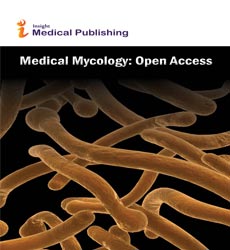The Group of Basidiomycete Structure
Joseph A Bentil
DOI10.36648/2471-8521.21.7.e008
Joseph A Bentil*
Department of Biochemistry and Biotechnology, Kwame Nkrumah University of Science and Technology, Kumasi, Ghana
- *Corresponding Author:
- Joseph A Bentil
Department of Biochemistry and Biotechnology, Kwame Nkrumah University of Science and Technology, Kumasi, Ghana
E-mail: benatilj@gmail.com
Received date: July 19, 2021; Accepted date: August 02, 2021; bAugust 09, 2021
Citation:Joseph A Bentil(2021) The Group of Basidiomycete Structure. Med Mycol Open Access Vol.7 No. 4: 008.
Introduction
Basidiomycota is one of two huge divisions that, along withthe Ascomycota, establish the subkingdom Dikarya (regularlyalluded to as the "higher organisms") inside the realm Fungi.Individuals are known as Basidiomycetes. All the more explicitly,Basidiomycota incorporates these gatherings: mushrooms,puffballs,stinkhorns,section growths, different polypores, jamorganisms, boletes, chanterelles, earth stars, mucks, hits, rusts,reflect yeasts, and Cryptococcus, the human pathogenic yeast.Basidiomycota are filamentous organisms made out of hyphae(aside from basidiomycota-yeast) and recreate physicallythrough the development of specific club-molded end cellsconsidered basidia that typically bear outside meiospores(normally four). These specific spores are called basidiospores.Be that as it may, some Basidiomycota are committing agamicreproducers. Basidiomycota that repeat abiogenetically (talkedabout beneath) can ordinarily be perceived as individuals fromthis division by net comparability to other people, by thedevelopment of a particular physical element (the braceassociation), cell divider segments, and absolutely byphylogenetic atomic examination of DNA grouping information.The growths in the Phylum Basidiomycota are effectivelyconspicuous under a light magnifying lens by their club-formedfruiting bodies called basidia (solitary, basidium), which are theenlarged terminal cell of a hypha. The basidia, which are theconceptive organs of these growths, are frequently containedinside the natural mushroom, ordinarily found in fieldsafterdownpour, on the general store retires, and becoming on yourgrass. The fruiting groups of a basidiomycete structure a ring in aglade, ordinarily called "pixie ring". The most popular pixie ringgrowth has the logical name Marasmius oreades. The body ofthis growth, its mycelium, is underground and fills outward allaround. As it develops, the mycelium drains the dirt of nitrogen,making the mycelia become away from the middle andprompting the "pixie ring" of fruiting bodies where there issatisfactory soil nitrogen.These mushroom-creating basidiomyces are now and thenalluded to as "gill parasites" on account of the presence of gill-like designs on the underside of the cap. The "gills" are reallycompacted hyphae on which the basidia are borne. Thisgathering likewise incorporates rack growth, which stick to thebark of trees like littleretires. Likewise, the basidiomycotaincorporates mucks and rusts, which are significant plantmicroorganisms, and toadstools. Most eatable organisms have aplace with the Phylum Basidiomycota; nonetheless, a fewbasidiomycetes produce destructive poisons. For instance,Cryptococcus neoformans causes extreme respiratory disease.Basidiomycota replicate agamically by one or the other maturingor abiogenetic spore arrangement. Sprouting happens when anoutgrowth of the parent cell is isolated into another cell. Any cellin the life form can bud. Abiogenetic spore arrangement, be thatas it may, frequently happens at the closures of particulardesigns called conidiophores. The septae of terminal cellsbecome completely characterized, partitioning an arbitrarynumber of cores into singular cells. The cell dividers then, at thatpoint thicken into a defensive coat. The ensured spores severand are dispensed. The lifecycle of basidiomycetes incorporatesrotation of ages. Spores are by and large delivered throughsexual generation, instead of agamic proliferation. The club-molded basidium conveys spores called basidiospores. In thebasidium, cores of two distinctivemating strains meld(karyogamy), leading to a diploid zygote that then, at that pointgoes through meiosis. The haploid cores relocate intobasidiospores, which grow and produce monokaryotic hyphae.The mycelium that outcomes are known as an essentialmycelium. Mycelia of various mating strains can join and createan auxiliary mycelium that contains haploid cores of twodistinctivemating strains. This is the dikaryotic phase of thebasidiomyces lifecyle and it is the predominant stage.Ultimately, the auxiliary mycelium creates a basidiocarp, whichis a fruiting body that juts starting from the earliest stage; is ouropinion about as a mushroom. The basidiocarp bears thecreating basidia on the gills under its cap. Basidiomycetes thatassault dead woody plants are the central specialists that rotcellulose and lignin are the fundamental segments of woodlandenvironments.
Open Access Journals
- Aquaculture & Veterinary Science
- Chemistry & Chemical Sciences
- Clinical Sciences
- Engineering
- General Science
- Genetics & Molecular Biology
- Health Care & Nursing
- Immunology & Microbiology
- Materials Science
- Mathematics & Physics
- Medical Sciences
- Neurology & Psychiatry
- Oncology & Cancer Science
- Pharmaceutical Sciences
